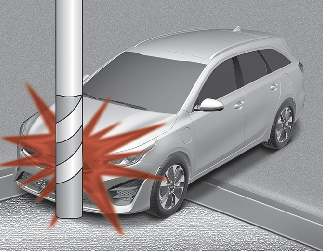Curtain air bag
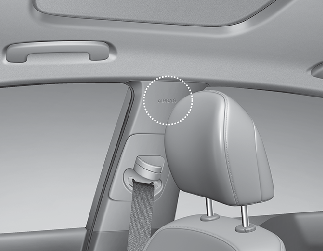
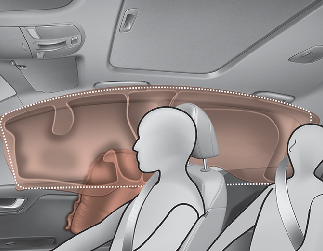
* The actual air bags in the vehicle may differ from the illustration.
Curtain air bags are located along both sides of the roof rails above the center pillar.
They are designed to help protect the heads of the front seat occupants and the rear outboard seat occupants in certain side impact collisions.
The curtain air bags are designed to deploy only during certain side impact collisions, depending on the crash severity, angle, speed and impact. The curtain air bags are not designed to deploy in all side impact situations, collisions from the front or rear of the vehicle or in most rollover situations.

-
In order for side and curtain air bags to provide their best protection, front seat occupants and outboard rear occupants should sit in an upright position with the seat belts properly fastened. Importantly, children should sit in a proper child restraint system in the rear seat.
-
When children are seated in the rear outboard seats, they must be seated in the proper child restraint system. Make sure to position the child restraint system as far away from the door side as possible, and secure the child restraint system in a locked position.
-
Do not allow the passengers to lean their heads or bodies onto doors, put their arms on the doors, stretch their arms out of the window, or place objects between the doors and passengers when they are seated on seats equipped with side and/or curtain air bags.
-
Never try to open or repair any components of the side curtain air bag system. If necessary, have the system serviced by a professional workshop. Kia recommends to visit an authorized Kia dealer/ service partner.
Failure to follow the above instructions can result in injury or death to the vehicle occupants in an accident.

No attaching objects
-
Do not place any objects over the air bag. Also, do not attach any objects around the area the air bag inflates such as the door, side door glass, front and rear pillar, roof side rail.
-
Do not hang hard or breakable objects on the clothes hanger.
Air bag collision sensors
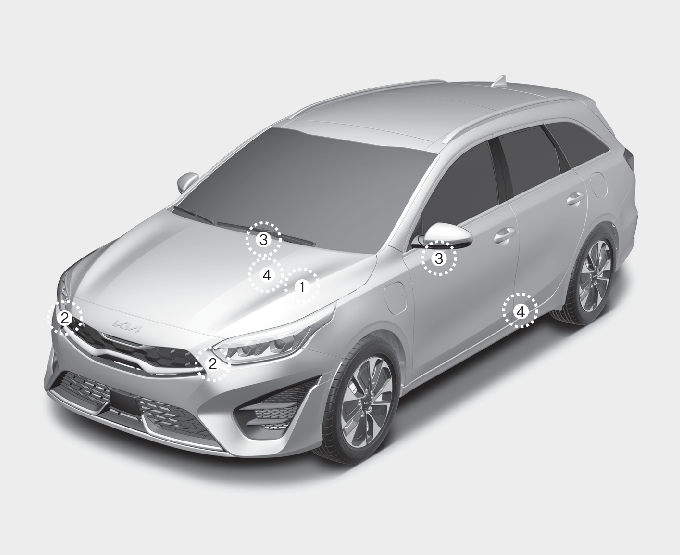
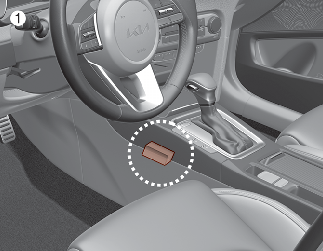 |
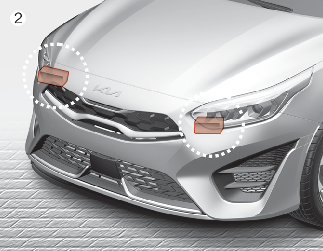 |
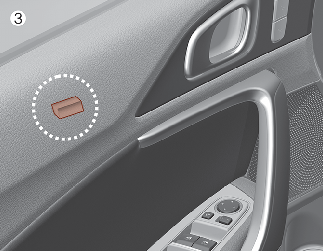 |
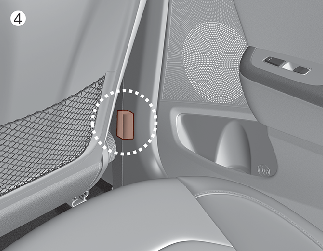 |
* The actual air bag collision sensors in the vehicle may differ from the illustration.
-
SRS control module
-
Front impact sensor
-
Side pressure sensors
-
Side impact sensor

-
Do not hit or allow any objects to impact the locations where air bags or sensors are installed.
This may cause unexpected air bag deployment, which could result in serious personal injury or death.
-
If the installation location or angle of the sensors is altered in any way, the air bags may deploy when they should not or they may not deploy when they should, causing severe injury or death.
Therefore, do not try to perform maintenance on or around the air bag sensors. Have the system serviced by a professional workshop. Kia recommends to visit an authorized Kia dealer/service partner.
-
Problems may arise if the sensor installation angles are changed due to the deformation of the front bumper, body or B pillars where side collision sensors are installed. In this case, have the system serviced by a professional workshop. Kia recommends to visit an authorized Kia dealer/ service partner.
-
Your vehicle has been designed to absorb impact and deploy the air bag(s) in certain collisions. Use only genuine parts or those of an equivalent standard to install bumper guards or replace a bumper. If not, it may adversely affect your vehicle’s collision and air bag deployment performance.
Why didn’t my air bag go off in a collision? (Inflation and non-inflation conditions of the air bag)
These include rear impacts, second or third collisions in multiple impact accidents, as well as low speed impacts.
Air bag inflation conditions
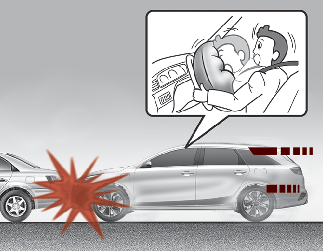
Front air bags are designed to inflate in a frontal collision depending on the intensity, speed or angles of impact of the front collision.
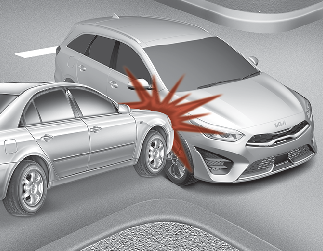
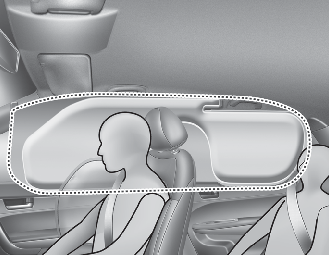
* The actual air bags in the vehicle may differ from the illustration.
Side and curtain air bags are designed to inflate when an impact is detected by side collision sensors depending on the strength, speed or angles of impact resulting from a side impact collision.
Although the front air bags (driver’s and front passenger’s air bags) are designed to inflate only in frontal collisions, they also may inflate in other types of collisions if the front impact sensors detect a sufficient impact. Side and curtain air bags are designed to inflate only in side impact collisions, but they may inflate in other collisions if the side impact sensors detect a sufficient impact.
If the vehicle chassis is impacted by bumps or objects on unimproved roads, the air bags may deploy. Drive carefully on unimproved roads or on surfaces not designed for vehicle traffic to prevent unintended air bag deployment.
Air bag non-inflation conditions
-
In certain low-speed collisions the air bags may not deploy. The air bags are designed not to deploy in such cases because they may not provide benefits beyond the protection of the seat belts in such collisions.
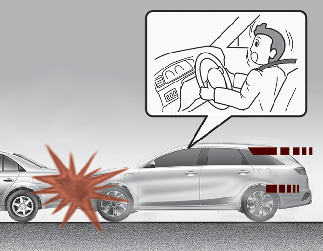
-
Frontal air bags are not designed to inflate in rear collisions, because occupants are moved backward by the force of the impact. In this case, inflated air bags would not be able to provide any additional benefit.
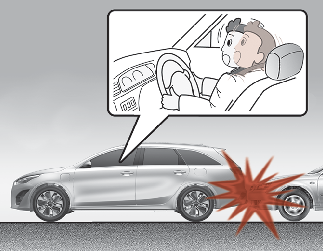
-
Front air bags may not inflate in side impact collisions, because occupants move to the direction of the collision, and thus in side impacts, frontal air bag deployment would not provide additional occupant protection.

However, side and curtain air bags may inflate depending on the intensity, vehicle speed and angles of impact.
-
In an angled collision, the force of impact may direct the occupants in a direction where the air bags would not be able to provide any additional benefit, and thus the sensors may not deploy any air bags.
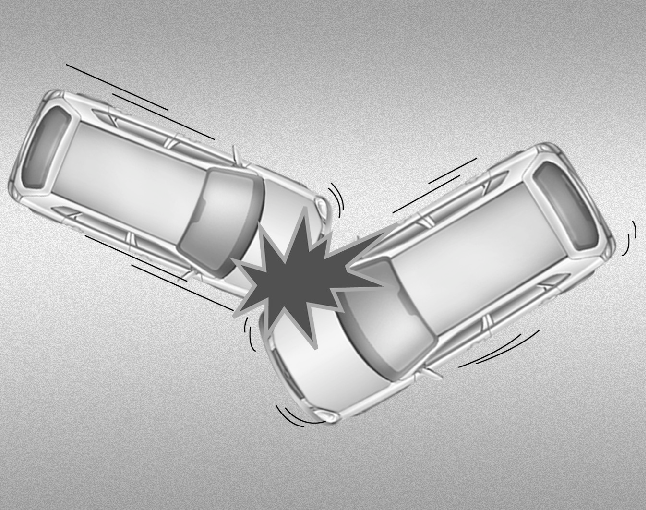
-
Just before impact, drivers often brake heavily. Such heavy braking lowers the front portion of the vehicle causing it to “ride” under a vehicle with a higher ground clearance. Air bags may not inflate in this "under-ride" situation because deceleration forces that are detected by sensors may be significantly reduced by such “under-ride” collisions.
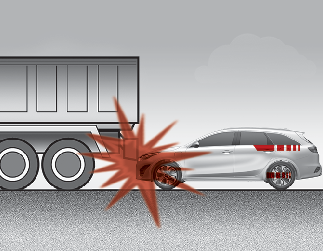
-
Air bags do not inflate in most rollover accidents, even though the vehicle is equipped with side air bags and curtain air bags.
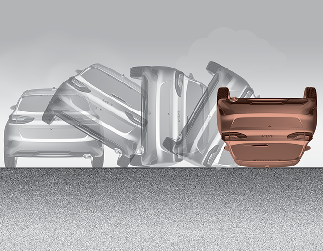
 NOTICE
NOTICEHowever, side and/or curtain air bags may inflate when the vehicle is rolled over by a side impact collision, if the vehicle is equipped with side air bags and curtain air bags.
 NOTICE
NOTICEWithout rollover sensor
However, side and/or curtain air bags may inflate when the vehicle is rolled over by a side impact collision, if the vehicle is equipped with side air bags and curtain air bags.
-
Air bags may not inflate if the vehicle collides with objects such as utility poles or trees, where the point of impact is concentrated to one area and the full force of the impact is not delivered to the sensors.
